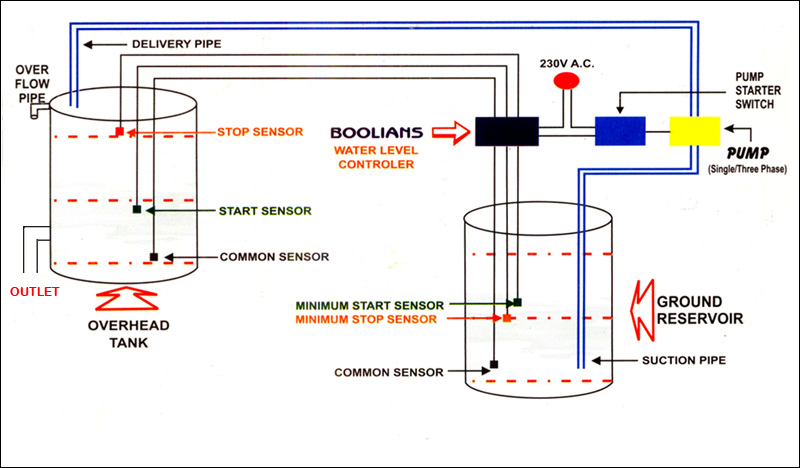AUTOMATIC WATER CONTROL SYSTEM
Automatic Water Control System
Automatic water level controllers are products created to automatically control the motor, which helps preserve a constant reserve of water in the storage tank. These automatic water level controllers are used to automatically fill the water tank when the motor starts or has become empty. It senses the water movement, demonstrates the water level inside the tank, and passes the information through pop-up messages to the smartphone. The water level sensor of the device is merged with the water tank and the flow of water, which is controlled by IR sensors. In this Forge Hitech uses PLC for programming; in that, all the inputs and outputs of relays, water level sensors, and WI-FI modules are connected to the input and output modules of the PLC.

The controller monitors both underground and overhead tanks using level sensors. The input is fed to a control panel which starts the pump whenever water is available in the underground tank and the overhead tank needs to be filled. The controller also stops the pump if the underground tank runs out of water or the overhead tank is filled. The motor will also switch off when the sump water is exhausted before it fills the overhead tank or if the pump is running dry as well as maintaining voltage fluctuations. Automatic water level controllers switch the motor on whenever the water level drops below a certain level and shuts the motor off when the water rises well above the fixed level. The automatic water level control device is capable of controlling the functions of the motor and helps to reduce power consumption. It also protects the motor from running dry and thus ensures durability. One of the main advantages of water level control devices includes the ability to control the power fluctuations when the motor is switched on. Most of these devices ensure an uninterrupted water supply by filling the overhead tank, once it is below a certain level. The motor power is switched on when the overhead tank becomes empty and switches off automatically when the underground tank is empty or the overhead tank becomes full.
Objectives
- Reduces wasting Water.
- Improve Water Quality.
- Enhance the efficiency of water systems.
- Implement leakage control.
Types of water level controllers
- Float Switch Sensor.
- Probe Level Sensor.
- Ultrasonic Level Sensor.
Features
- Microcontroller-based intelligent circuit easily fits to the starter.
- Overhead tank sump water level sensing.
- Capable of controlling up to 2hP motor.
- In-built dry run protection.
- Easy installation and suitable for both contact and non-contact types
Advantages
- Automatic function and conserve energy.
- Low maintenance.
- An automatic water level controller can maintain an exact preset water level.
- It can be used in homes, hotels, and hospitals.
- These controllers are compact, easy to install, and easy to move.
- The sensor can be free of corrosion and maintenance cost is low.
